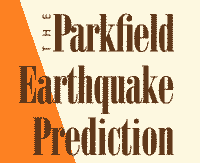In 1985, the USGS developed a plan, detailed in OF 87-192, on which it would base earthquake warnings for Parkfield and has assisted state, county, and local officials in the Parkfield area to prepare a coordinated, reasonable response to a warning, should one be issued. Recent changes have been made to this alert system. The plan defines four "status levels" (A, B, C and D), that may be issued when specified observations of earthquake activity or fault creep are made. The status levels and criteria for meeting them are summarized in an status scheme table.
Under the plan, the USGS would notify the California Office of Emergency Services (OES) when a Status A is declared. California OES has the responsibility to disseminate hazard warnings to the public, to county and local officials, and to the press. A public warning will be issued by OES whenever the USGS declares an A-status. Status A alerts not followed within 72 hours by the anticipated Parkfield earthquake are considered false alarms. Status B, C and D signify periods of increased earthquake likelihood, but are not of sufficient concern to warrant public warnings. The history of status levels declared at Parkfield are summarized in 17 status history tables.

The earthquake prediction at Parkfield was announced to the public by the Director of the USGS in April, 1985. The announcement stated that there was a 90% probability of an earthquake with Magnitude 5.5 to 6.0 occurring sometime between 1985 and 1993. The prediction drew great media attention.
The California OES mailed a detailed brochure about the earthquake prediction to more than 122,000 households in the Parkfield area. Entitled "The Parkfield Earthquake Prediction," the brochure included information about the earthquake hazard, the prediction, a possible short-term warning, and how to prepare for and respond to the earthquake. The affected counties participated in the public information program.
An assessment of the public's understanding of and response to the information provided about the prediction was reported in Fostering Public Preparations for Natural Hazards (Mileti et al., 1992). Mileti and his coworkers surveyed three communities within the Parkfield area. They found that almost everyone in the surveyed communities had heard about the prediction; that the information enhanced the public's perception of earthquake risk; and that the information prompted many people to prepare for the anticipated earthquake.
 Jump to Navigation
Jump to Navigation